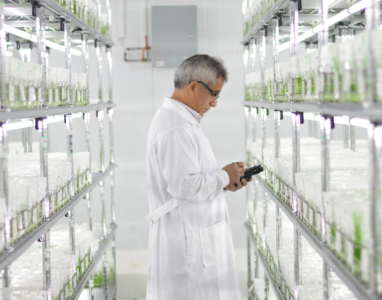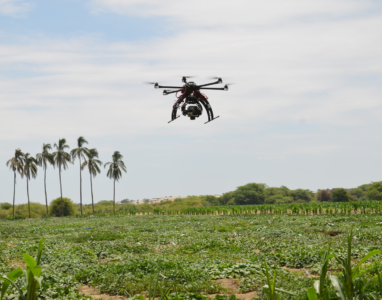 While CGIAR scientists have long used big data in their research for development, the COVID-19 pandemic highlights the urgency of harnessing its full potential to accelerate the delivery of technologies that increase food and nutrition security, build resilience to global shocks, and contribute to the transformation of food systems.
While CGIAR scientists have long used big data in their research for development, the COVID-19 pandemic highlights the urgency of harnessing its full potential to accelerate the delivery of technologies that increase food and nutrition security, build resilience to global shocks, and contribute to the transformation of food systems.
“Scientific information is needed now more than ever before, to help people make decisions in this crisis that agri-food systems are facing,” observed Oscar Ortiz, the International Potato Center’s (CIP) deputy director general for research and development.
Ortiz explained that CIP is increasingly tapping the power of big data to enhance its work, from the conservation of biodiversity held in its genebank, to breeding climate-resilient crop varieties, to developing agronomic tools that enable men and women farmers to produce more nutritious food.
The genebank has digitalized and increased the information available on the approximately 20,000 accessions it safeguards – among the world’s largest collections of potato, sweetpotato and Andean root and tuber agrobiodiversity. A growing number of those accessions have been genotyped and screened for useful traits, such as disease resistance or heat tolerance. That information is being made available to scientists across the globe through the genebank website and bioinformatics pipelines established under G2P-SOL – an international research alliance focused on potato, tomato, peppers and eggplant.
Accelerating breeding
Data-driven crop improvement accelerates the development of the resilient varieties needed to raise food production by 60 percent while adapting to climate change. Genomic data play an important role in this, and CIP has been using that data since participating in the international group that published the first potato genome sequence in 2011.
While genetic sequencing creates massive amounts of data, using it for crop improvement requires correlation with field and greenhouse assessments of thousands of plants, which also generates mega data. Breeders prioritize the development of resilient, nutritious crop varieties, but those varieties also need to have characteristics such as color, consistency or cooking time that consumers want.
Ongoing research in Africa to identify and understand priority traits for specific markets is generating another layer of data that breeders can use to develop varieties that are more likely to be widely adopted. Examples include a recent household survey of sweetpotato trait preferences in Uganda led by the company AbacusBio, and RTBFoods, a multi-partner, regional initiative that is generating information and tools to help breeders develop improved banana, cassava, potato and sweetpotato varieties with the characteristics that African farmers, processors and consumers want.
To facilitate and accelerate the development of resilient, nutritious crop varieties for African or Asian farmers and consumers, CIP is working with national partners to improve the collection and use of breeding data through standardized protocols and digital technologies, with help from the CGIAR Excellence in Breeding Platform. Breeders at national research institutes who until recently recorded data from field or greenhouse trials with a pen and paper, and later transferred it into excel sheets on their computers, now record the data on tablets using the “Field Book” app and upload it directly into a database such as SweetPotatoBase – one of various online, crop-specific breeding support platforms hosted by the Boyce Thompson Institute. This not only boosts the efficiency of national breeding programs, it facilitates data sharing, international collaboration and meta analysis.
Tapping technology
Another innovation that a growing number of breeders have adopted is the use of drones equipped with multi-spectral or thermographic cameras to collect data in field trials. The images produced are used to evaluate plants’ disease resistance, or heat or drought tolerance – increasingly important traits in a climate-changing world.
 Drone images played a key role in a mass field screening of 1,973 sweetpotato accessions from three continents in the desert of northern Peru, the results of which were recently published in Nature Climate Change.
Drone images played a key role in a mass field screening of 1,973 sweetpotato accessions from three continents in the desert of northern Peru, the results of which were recently published in Nature Climate Change.
“The advantage of remote sensing technology is that we were able to get a thermal snapshot of 1,973 accessions at a precise moment,” said Bettina Heider, CIP researcher and lead author of the article in Nature Climate Change.
CIP scientists are currently evaluating the use of drones to collect data in field trials to identify potatoes resistant to late blight – a disease that destroys USD billions worth of potatoes globally each year. Technicians have always recorded that data on the ground, walking through fields for eight-hour shifts over the course months.
“We want to replace a labor-intensive system with a camera. It takes less than an hour for the drone to fly over a field and record the disease’s progress,” said Hannele Lindqvist-Kreuze, interim head of CIP’s crop improvement division. “Potential savings are huge with this technology.”
While the climate-resilient, disease-resistant crop varieties currently being developed will be essential for increasing agricultural production over the next three decades, that will also require technologies to help small-scale farmers improve their crop management. CIP and partners are also developing digital tools such as phone apps that can help farmers manage crop diseases or optimize their use of water in irrigation.
“From conserving genetic diversity to developing new varieties faster, and making decisions for crop management, agronomy, soil and landscape management, or climate change adaptation. All of that will be supported by big data, and the tools we are creating with artificial intelligence,” affirmed Ortiz.
Blog by David Dudenhoefer
